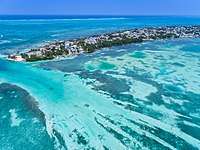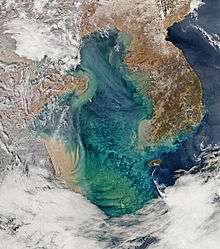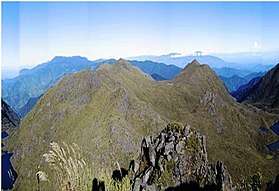IUCN Red List of Ecosystems
The IUCN Red List of Ecosystems (RLE) is a global framework for monitoring and documenting the status of ecosystems. It was developed by the International Union for Conservation of Nature as part of the growing toolkit for biodiversity risk assessment. Its main objective is to support conservation, resource use, and management decisions by evaluating all the world's ecosystems by 2025.
With the help of RLE and its partner organizations, many governments and organizations create their own national and regional red lists (generally based on the IUCN categories and criteria), in which they classify the ecosystems under threat within their territorial limits.
History
The Red List of Ecosystems was created when the need arose to carry out assessments of biodiversity at a level of biological organization above species.[2] Existing ecosystem assessment protocols, developed by national or subnational authorities differed in focus and implementation, were often incomparable, and unable of separating strict risk analysis from the process of setting conservation priorities.[3][4]
In 2008, during the IV World Conservation Congress (Barcelona, Spain), the process of developing criteria to estimate their risk status was activated and the IUCN laid the foundations for the creation of a Red List of Ecosystems (RLE). The initial development of the criteria for the Red List of ecosystems was based on analogies with the criteria for species and on existing protocols designed for regional applications.[5][6]
In 2013, the process of creating The Categories and Criteria of the IUCN Red List Ecosystems, the base of the IUCN Red List of Ecosystems, was finalized. That same year, the key document "Scientific Foundations of an IUCN Red List of Ecosystems" was published to provide a consistent, practical and theory-based framework for establishing a systematic Red List of the world's ecosystems. [1]
The RLE was officially recognized by IUCN in 2014, to be managed as a Thematic Group under the IUCN Commission on Ecosystem Management (CEM).
The Red List of Ecosystems as a tool


Like other IUCN products, the LRE is a key tool that provides a unique opportunity to facilitate the achievement of international conservation objectives and allows to assess an ecosystem's danger of collapse either globally or by portions developed over a region, country, subnational entity, etc.
This provides a means to make more effective territorial arrangements, minimizing the impacts that the anthropic transformations of large surfaces entail; It also contributes to a better management of the limited resources devoted to conservation, prioritizing those ecosystems with the most imminent chances of disappearing based on their conditions , redirecting on them the greatest efforts to mitigate the environmental threats that affect them, as well as the creation of effective protected areas that will safeguard them for future generations.
Risk Categories

The acronyms of the RLE risk categories (CO, CR, EN, VU, NT, LC, DD, NE) are in English and, unlike others, do not change in line with the language in which the document where they appear is written.
Collapsed (CO)
An ecosystem is Collapsed when it is virtually certain that its defining biotic or abiotic features are lost from all occurrences, and the characteristic native biota are no longer sustained. This category is only assigned when assessors are virtually certain (>99% probability) of the assessment outcome, otherwise, if Collapsed is the more likely category, it should listed as Critically Endangered with upper bound of Collapsed.[11]
Collapse is considered an endpoint of ecosystem decline and degradation and is thus the most extreme outcome of the risk assessment protocol. For this reason, this category must only be assigned when the evidence complies a very high standard. Unlike the analogous process of species extinction, collapse is theoretically reversible.[12] In other assessment protocols, the terms 'extinct', 'eliminated' or 'disappeared' are often used instead of 'collapsed'.[5][13]
Critically endangered (CR)
An ecosystem is Critically Endangered when the best available evidence indicates that it meets any of the criteria A to E for Critically Endangered. It is therefore considered to be at an extremely high risk of collapse. Formally this represents a 50% probability of collapse in a time frame of 50 years into the future (according to criterion E).[11] In practice, this category is delimited by thresholds based on a compromise between theoretical and practical considerations:[12] For criteria related to decline in ecosystem distribution (criterion A), degradation of abiotic environment (criterion C) and disruption of biotic interactions and processes (criterion D) the threshold values were set at high values for current and future declines (80%), and a higher value for historical declines (90%). For the assessment of restricted distribution (criterion B) the thresholds have been set following several simulation tests regarding the effect of spatially explicit threats on ecosystems with different spatial configurations.[11][14][15]
Endangered (EN)
An ecosystem is Endangered when the best available evidence indicates that it meets any of the criteria A to E for Endangered. It is therefore considered to be at a very high risk of collapse. Formally this represents a 20% probability of collapse in a time frame of 50 years into the future (according to criterion E). For criteria related to decline in ecosystem distribution (criterion A), degradation of abiotic environment (criterion C) and disruption of biotic interactions and processes (criterion D) the threshold values were set at intermediate values for current and future declines (50%), and a higher value for historical declines (70%). For the assessment of restricted distribution (criterion B) the thresholds have been set following several simulation tests regarding the effect of spatially explicit threats on ecosystems with different spatial configurations.[11][14]
Vulnerable (VU)
An ecosystem is Vulnerable when the best available evidence indicates that it meets any of the criteria A to E for Vulnerable. It is therefore considered to be at a high risk of collapse. Formally this represents a 10% probability of collapse in a time frame of 100 years into the future (according to criterion E). For criteria related to decline in ecosystem distribution (criterion A), degradation of abiotic environment (criterion C) and disruption of biotic interactions and processes (criterion D) the threshold values were set at low values for current and future declines (30%), and an intermediate value for historical declines (50%). For the assessment of restricted distribution (criterion B) the thresholds have been set following several simulation tests regarding the effect of spatially explicit threats on ecosystems with different spatial configurations.[11][14]
Near Threatened (NT)
An ecosystem is Near Threatened when it has been evaluated against the criteria but does not qualify for Critically Endangered, Endangered or Vulnerable now, but is close to qualifying for or is likely to qualify for a threatened category in the near future.
Least Concern (LC)
An ecosystem is Least Concern when it has been evaluated against the criteria and does not qualify for Critically Endangered, Endangered, Vulnerable or Near Threatened. Widely distributed and relatively undegraded ecosystems are included in this category. Theoretically, all ecosystems have some risk of collapse, just as all species face some risk of extinction. The term Least concern reflects the fact that this risk is relatively low. In practice this category is reserved for ecosystems that unambiguously meet none of the quantitative criteria (decline in distribution, restricted distribution, degradation of environmental conditions or disruption of biotic processes and interactions).[12]
Data Deficient (DD)
An ecosystem is Data Deficient when there is inadequate information to make a direct, or indirect, assessment of its risk of collapse based on decline in distribution, disruption of ecological function or degradation of the physical environment. Data Deficient is not a category of threat, and does not imply any level of collapse risk. Listing of ecosystems in this category indicates that their situation has been reviewed, but that more information is required to determine their risk status.
Not Evaluated (NE)
An ecosystem is Not Evaluated when it is has not yet been evaluated against the criteria. The category of 'Not Evaluated' does not indicate that a ecosystem is not at risk from collapse, but simply that the ecosystem has not yet been studied for any risk to be quantified and published.
Criteria (A-E)
Two of the criteria for assigning ecosystems to a risk category evaluate the spatial symptoms of the ecosystem's collapse: decrease in distribution (A) and restricted distribution (B). Two criteria evaluate the functional symptoms of the ecosystem’s collapse: environmental degradation (C) and interruption of biotic processes and interactions (D). Multiple threats and symptoms can be integrated into an ecosystem dynamics model to produce quantitative estimates of the risk of collapse (E).
Guidelines for the application of IUCN Red List of Ecosystems Categories and Criteria
The Guidelines for the application of IUCN Red List of Ecosystems Categories and Criteria are documents that help the correct application of the Categories and Criteria of the IUCN Red List of Ecosystems, providing information on the development of the protocol and a detailed description of the scientific foundations that support the categories and criteria. To date, two versions have been published:
- Version 1.0 (2016)
- Version 1.1 (2017)[11]
Impacts, critique and challenges
The development of the IUCN Red List of Ecosystems considered tradeoffs between generality, precision, realism and simplicity. Conceptual and operational weaknesses of the RLE approach, categories, and criteria have been discussed and debated. A fair evaluation of it effectiveness and importance needs to consider its real achievements in conservation and natural resource management, a balance between benefits and limitations and its performance against alternative methods.[12]
The Red List of Ecosystems is a relatively recent knowledge product for informing policy and advise decision makers and practitioners, and it is still difficult to measure its medium and long term impact. Overall investment has been modest compared to other, long standing conservation knowledge products, but its reception in public audiences and media has been positive. [16] It is considered a potentially important tool for creating indicators of progress of international policy, such as the Aichi Biodiversity Targets and the Sustainable Development Goals, but it is still lacking widespread implementation and adoption.[17][18]
Some arguments against the wide adoption of the RLE are the lack of consistent means to classify ecosystems for assessing conservation status, technical difficulties with the concept of ecosystem collapse and lack of scientific basis for the criteria and thresholds.[19] Classification and spatial representation of ecosystems is a major challenge in itself.[20]
The concept of ecosystem collapse is still a major point of debate. Despite the strong empirical evidence, anticipating collapse is a complex problem.[21] Although states of ecosystem collapse are often defined quantitatively, few studies adequately describe transitions from pristine or original state towards collapse.[22]
Given the real need to evaluate risk to ecosystems and set national and regional conservation priorities, there is a clear advantages in using a flexible and standard approach that is comparable between regions and countries. This would save time and resources previously used to develop local guidelines, and would allow regions to share and compare experiences, and avoid common pitfalls.[4][12]
See also
References
- 1 2 3 4 Keith, DA; Rodríguez, J.P.; Rodríguez-Clark, K.M.; Aapala, K.; Alonso, A.; Asmussen, M.; Bachman, S.; Bassett, A.; Barrow, E.G.; Benson, J.S.; Bishop, M.J.; Bonifacio, R.; Brooks, T.M.; Burgman, M.A.; Comer, P.; Comín, F.A.; Essl, F.; Faber-Langendoen, D.; Fairweather, P.G.; Holdaway, R.J.; Jennings, M.; Kingsford, R.T.; Lester, R.E.; Mac Nally, R.; McCarthy, M.A.; Moat, J.; Nicholson, E.; Oliveira-Miranda, M.A.; Pisanu, P.; Poulin, B.; Riecken, U.; Spalding, M.D.; Zambrano-Martínez, S. (2013). "Scientific Foundations for an IUCN Red List of Ecosystems". PLoS One. 8 (5): e62111. doi:10.1371/journal.pone.0062111. PMC 3648534. PMID 23667454. Retrieved 8 September 2018.
- ↑ Rodríguez, J.P. (2010). "Threatened Ecosystems. Join a global network for developing an IUCN Red List for imperiled ecosystems" (PDF). Society for Conservation Biology Newsletter. 17 (4): 2–3. Retrieved 10 September 2018.
- ↑ Keith, David A. (2014). "Separating risks from values in setting priorities for plant community conservation". Applied Vegetation Science. 17 (3): 384–385. doi:10.1111/avsc.12112. ISSN 1402-2001.
- 1 2 Nicholson, Emily; Regan, Tracey J.; Auld, Tony D.; Burns, Emma L.; Chisholm, Laurie A.; English, Valerie; Harris, Stephen; Harrison, Peter; Kingsford, Richard T.; Leishman, Michelle R.; Metcalfe, Daniel J.; Pisanu, Phil; Watson, Christopher J.; White, Matthew; White, Matt D.; Williams, Richard J.; Wilson, Bruce; Keith, David A. (2015). "Towards consistency, rigour and compatibility of risk assessments for ecosystems and ecological communities". Austral Ecology. 40 (4): 347–363. doi:10.1111/aec.12148. ISSN 1442-9985.
- 1 2 Rodríguez, Jon Paul; Balch, Jennifer K.; Rodríguez-Clark, Kathryn M. (2006). "Assessing extinction risk in the absence of species-level data: quantitative criteria for terrestrial ecosystems". Biodiversity and Conservation. 16 (1): 183–209. doi:10.1007/s10531-006-9102-1. ISSN 0960-3115.
- ↑ Rodríguez, Jon Paul; Rodríguez-Clark, Kathryn M.; Keith, David A.; Barrow, Edmund G.; Benson, John; Nicholson, Emily; Wit, Piet (2012). "IUCN Red List of Ecosystems". Sapiens. 5 (2). Retrieved 10 September 2018.
- ↑ Bland, L.; Regan, T.; Ngoc Dinh, M.; Ferrari, R.; Keith, D.; Lester, R.; Mouillot, D.; Murray, N.; Anh Nguyen, H.; Nicholson, E. (2017). "Meso-American Reef: Using multiple lines of evidence to assess the risk of ecosystem collapse". Proceedings of the Royal Society B. 284 (1863): 20170660. doi:10.1098/rspb.2017.0660. PMC 5627190. PMID 28931744. Retrieved 9 September 2018.
- ↑ Murray, Nicholas J.; Ma, Zhijun; Fuller, Richard A. (2015). "Tidal flats of the Yellow Sea: A review of ecosystem status and anthropogenic threats". Austral Ecology. 40 (4): 472–481. doi:10.1111/aec.12211. ISSN 1442-9985.
- ↑ Rodríguez, J.P.; Rojas-Suárez, F.; Giraldo Hernández, D. (2010). Red Book of Venezuelan Terrestrial Ecosystems (PDF). Caracas, Venezuela: Provita. Retrieved 10 September 2018.
- ↑ Herrera – F, B .; Zamora, N.; Chacón, O. (2015). Lista Roja de los Ecosistemas Terrestres de Costa Rica: Informe final de proyecto (PDF). Turrialba – Costa Rica: CATIE. pp. 75 p. Retrieved 13 September 2018.
- 1 2 3 4 5 6 Bland, L.M.; Keith, D. A.; Miller, R.; Murray, N.J.; Rodríguez, J.P. (2017). Guidelines for the application of IUCN Red List of Ecosystems Categories and Criteria (Version 1.1. ed.). Gland, Switzerland: IUCN. pp. ix + 99pp. Retrieved 10 September 2018.
- 1 2 3 4 5 Keith, David A.; Rodríguez, Jon Paul; Brooks, Thomas M.; Burgman, Mark A.; Barrow, Edmund G.; Bland, Lucie; Comer, Patrick J.; Franklin, Janet; Link, Jason; McCarthy, Michael A.; Miller, Rebecca M.; Murray, Nicholas J.; Nel, Jeanne; Nicholson, Emily; Oliveira-Miranda, María A.; Regan, Tracey J.; Rodríguez-Clark, Kathryn M.; Rouget, Mathieu; Spalding, Mark D. (2015). "The IUCN Red List of Ecosystems: Motivations, Challenges, and Applications". Conservation Letters. 8 (3): 214–226. doi:10.1111/conl.12167. ISSN 1755-263X.
- ↑ Rodríguez, Jon Paul; Rodríguez-Clark, Kathryn M.; Baillie, Jonathan E. M.; Ash, Neville; Benson, John; Boucher, Timothy; Brown, Claire; Burgess, Neil D.; Collen, Ben; Jennings, Michael; Keith, David A.; Nicholson, Emily; Revenga, Carmen; Reyers, Belinda; Rouget, Mathieu; Smith, Tammy; Spalding, Mark; Taber, Andrew; Walpole, Matt; Zager, Irene; Zamin, Tara (2011). "Establishing IUCN Red List Criteria for Threatened Ecosystems". Conservation Biology. 25 (1): 21–29. doi:10.1111/j.1523-1739.2010.01598.x. ISSN 0888-8892.
- 1 2 3 Murray, Nicholas J.; Keith, David A.; Bland, Lucie M.; Nicholson, Emily; Regan, Tracey J.; Rodríguez, Jon Paul; Bedward, Michael; Roura-Pascual, Núria (2017). "The use of range size to assess risks to biodiversity from stochastic threats". Diversity and Distributions. 23 (5): 474–483. doi:10.1111/ddi.12533. ISSN 1366-9516.
- ↑ Keith, David A.; Akçakaya, H. Resit; Murray, Nicholas J. (2018). "Scaling range sizes to threats for robust predictions of risks to biodiversity". Conservation Biology. 32 (2): 322–332. doi:10.1111/cobi.12988. ISSN 0888-8892.
- ↑ Juffe-Bignoli, Diego; Brooks, Thomas M.; Butchart, Stuart H. M.; Jenkins, Richard B.; Boe, Kaia; Hoffmann, Michael; Angulo, Ariadne; Bachman, Steve; Böhm, Monika; Brummitt, Neil; Carpenter, Kent E.; Comer, Pat J.; Cox, Neil; Cuttelod, Annabelle; Darwall, William R. T.; Di Marco, Moreno; Fishpool, Lincoln D. C.; Goettsch, Bárbara; Heath, Melanie; Hilton-Taylor, Craig; Hutton, Jon; Johnson, Tim; Joolia, Ackbar; Keith, David A.; Langhammer, Penny F.; Luedtke, Jennifer; Nic Lughadha, Eimear; Lutz, Maiko; May, Ian; Miller, Rebecca M.; Oliveira-Miranda, María A.; Parr, Mike; Pollock, Caroline M.; Ralph, Gina; Rodríguez, Jon Paul; Rondinini, Carlo; Smart, Jane; Stuart, Simon; Symes, Andy; Tordoff, Andrew W.; Woodley, Stephen; Young, Bruce; Kingston, Naomi (2016). "Assessing the Cost of Global Biodiversity and Conservation Knowledge". PLOS ONE. 11 (8): e0160640. doi:10.1371/journal.pone.0160640. ISSN 1932-6203. Missing
|last1=in Authors list (help) - ↑ "The policy impact of scientific research: looking back at 10 years of PLOS ONE". PLOS Collections. PLOS Blogs. Retrieved 20 September 2018.
- ↑ Brooks, Thomas M.; Butchart, Stuart H.M.; Cox, Neil A.; Heath, Melanie; Hilton-Taylor, Craig; Hoffmann, Michael; Kingston, Naomi; Rodríguez, Jon Paul; Stuart, Simon N.; Smart, Jane (2015). "Harnessing biodiversity and conservation knowledge products to track the Aichi Targets and Sustainable Development Goals". Biodiversity. 16 (2–3): 157–174. doi:10.1080/14888386.2015.1075903. ISSN 1488-8386.
- ↑ Boitani, Luigi; Mace, Georgina M.; Rondinini, Carlo (2014). "Challenging the Scientific Foundations for an IUCN Red List of Ecosystems". Conservation Letters. 8 (2): 125–131. doi:10.1111/conl.12111.
- ↑ Gigante, Daniela; Foggi, Bruno; Venanzoni, Roberto; Viciani, Daniele; Buffa, Gabriella (2016). "Habitats on the grid: The spatial dimension does matter for red-listing". Journal for Nature Conservation. 32: 1–9. doi:10.1016/j.jnc.2016.03.007. hdl:10278/3671359.
- ↑ Sato, Chloe F.; Lindenmayer, David B. (2018). "Meeting the Global Ecosystem Collapse Challenge". Conservation Letters. 11 (1): e12348. doi:10.1111/conl.12348.
- ↑ Bland, L.; Rowland, J.; Regan, T.; Keith, D.; Murray, N.; Lester, R.; Linn, M.; Rodríguez, J.P.; Nicholson, E. (2018). "Developing a standarized definition of ecosystem collapse for risk assessment". Frontiers in Ecology and the Environment. 16 (1): 29–36. doi:10.1002/fee.1747.

%2C_roseli%C3%A8re_situ%C3%A9es_%C3%A0_l%E2%80%99ouest_de_la_digue_d'Harchies.jpg)